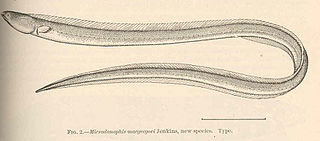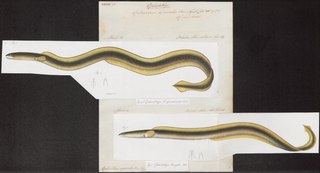Ichthyapus is a genus of eels in the snake eel family Ophichthidae.

The Duckbill oceanic eel is an eel in the family Derichthyidae. It was described by Johannes Schmidt in 1912. It is a marine, deep water-dwelling eel which is known from France, Morocco, the Cape of Good Hope, and South Africa in the eastern Atlantic Ocean, as well as from the western Atlantic, southwestern Indian, and southwestern Pacific. It dwells at a depth range of 0–1800 metres, inhabiting the mesopelagic zone. Males can reach a maximum total length of 58.9 centimetres.
The Longtailed sand-eel is an eel in the family Ophichthidae. It was described by Albert Günther in 1870, originally under the genus Ophichthys. It is a marine, tropical eel, which is known from Aden to Natal, South Africa, in the western Indian Ocean. Males can reach a maximum total length of 54 centimetres (21 in).

The fringelip snake-eel is an eel in the family Ophichthidae. It was described by Albert Günther in 1870. It is a marine, tropical eel which is known from the Indo-Pacific, including Zanzibar, Tanzania, Kosi Bay, South Africa, and the Hawaiian Islands. Its lifestyle is mostly benthic but it sometimes swims at the surface. It is olive brown in colour, with lighter colouring in the ventral region. Males can reach a maximum total length of 39 centimetres (15 in).
Dalophis obtusirostris is an eel in the family Ophichthidae. It was described by Jacques Blache and Marie-Louise Bauchot in 1972. It is a tropical, marine eel which is known from the eastern Atlantic Ocean, including Mauritania and Senegal. It inhabits estuaries and forms burrows in sand or mud. Males can reach a maximum total length of 38.8 centimetres.
Ethadophis epinepheli is an eel in the family Ophichthidae. It was described by Jacques Blache and Marie-Louise Bauchot in 1972. It is a tropical, marine eel which is known from a single specimen recovered from the stomach of a grouper in Senegal, in the eastern Atlantic Ocean. It is known to reach a total length of 42.4 centimetres.
Ichthyapus insularis is an eel in the family Ophichthidae. It was described by John E. McCosker in 2004. It is a tropical saltwater eel found only around Ascension Island in the southeastern Atlantic Ocean. It is known to dwell at a depth range of 0 to 1 metre and lives among rocks and sand. Males can reach a total length of 42.7 centimetres (16.8 in).
Ichthyapus platyrhynchus is an eel in the family Ophichthidae. It was described by William Alonzo Gosline III in 1951. It is a marine, tropical eel which is known from Hawaii, in the eastern Pacific Ocean. It forms burrows in sand sediments.
The smiling snake eel is an eel in the family Ophichthidae. It was described by David Starr Jordan and Charles Henry Gilbert in 1882, originally under the genus Apterichthys. It is a marine, tropical eel which is known from the eastern central and southeastern Pacific Ocean, including Colombia, Costa Rica, Panama, Ecuador, and Mexico. It dwells at a maximum depth of 30 metres (98 ft), and inhabits sediments of sand. Males can reach a maximum total length of 41 centimetres (16 in).
The Vulture sand eel is an eel in the family Ophichthidae. It was described by Max Carl Wilhelm Weber and Lieven Ferdinand de Beaufort in 1916, originally under the genus Sphagebranchus. It is a marine, tropical eel which is known from the Indo-Pacific, including Mascarenes, Pitcairn, Japan, Australia, Micronesia, and Easter Island. It dwells in inshore waters at a depth range of 2 to 18 metres, and forms burrows in soft, sandy sediments.

The saddled snake-eel is an eel in the family Ophichthidae. It was described by George Tradescant Lay and Edward Turner Bennett in 1839, originally under the genus Ophisurus. It is a marine, tropical eel which is known from the Indo-Pacific and southeastern Atlantic Ocean, including East and South Africa, the Hawaiian Islands, the Marquesan Islands, the Mangaréva islands, Japan, and Australia. It dwells at a depth range of 0 to 70 metres, most often around 0 to 10 metres, and inhabits lagoons and reefs, in which it forms burrows in beds of seagrass and sandy areas. Males can reach a maximum total length of 66 centimetres (2.17 ft).

The bluntnose snake eel is an eel in the family Ophichthidae. The author of the species is anonymous, but it has been referred to Edward Turner Bennett in 1830. It is a tropical, marine eel which is known from the Indo-Pacific, including Kenya, Madagascar, South Africa, Taiwan, Thailand, and the Philippines. It dwells at a maximum depth of 22 m, but also frequents shores. Males can reach a maximum total length of 45 cm.

The Napoleon snake eel is an eel in the family Ophichthidae. It was described by Johann Jakob Kaup in 1856, originally under the genus Poecilocephalus. It is a marine, tropical eel which is known from the Indo-Pacific, including Durban, South Africa, Mauritius, Indonesia, Japan, Australia, and the Penghu Islands. It is known to dwell at a depth of 20 metres (66 ft), and inhabits lagoons and reefs; it forms solitary burrows in sand sediments. Males can reach a maximum total length of 75 centimetres (30 in).
Ophichthus serpentinus, known commonly as the slender snake-eel in South Africa, is an eel in the family Ophichthidae. It was described by Alvin Seale in 1917. It is a marine, subtropical eel which is known from the southeastern Atlantic Ocean, including Namibia and South Africa. It dwells at a depth range of 235 to 490 metres. Males can reach a maximum total length of 68 centimetres (27 in).
The plain snake eel is an eel in the family Ophichthidae. It was described by Charles Tate Regan in 1908. It is a marine, subtropical eel which is known from Algoa Bay, South Africa, in the southeastern Atlantic Ocean. Males can reach a maximum total length of 30 centimetres (12 in).

The rice-paddy eel is an eel in the family Ophichthidae. It was described by Francis Buchanan-Hamilton in 1822, originally in the genus Ophisurus. It is a tropical, marine eel which is known from the Indo-West Pacific, including Somalia, Tanzania, South Africa, southern India, Sri Lanka, Indonesia, Polynesia, Australia, Bangladesh, Cambodia, Kenya, Madagascar, the Philippines, Malaysia, Mozambique, Seychelles, Saudi Arabia, Taiwan, China, Thailand, Vietnam, and southern Yemen. It is an anadromous species and spawns in freshwater, often in rice paddies during the rainy season, earning it its common name. It also spends time in lagoons, estuaries and coastal rivers, in which it lives in burrows in the river bottom and bank. Males can reach a maximum total length (TL) of 100 centimetres, but more commonly reach a TL of 70 cm.
The Southern snipe eel is an eel in the family Nemichthyidae. It was described by Charles Tate Regan in 1916, originally under the genus Leptocephalus. It is a marine, deep water-dwelling eel which is known from throughout the southern regions of the ocean, with the exception of the eastern Pacific. It is known to dwell at a maximum depth of 2,000 metres (6,600 ft). Males can reach a maximum total length of 77 centimetres (30 in).

The Bean's sawtooth eel is an eel in the family Nemichthyidae. It was described by Theodore Gill and John Adam Ryder in 1883. It is a marine, deep water-dwelling eel which is known from throughout the Atlantic Ocean, the Indian Ocean, and the Western Pacific Ocean, including Iceland, South Africa, Réunion, and Australia. It dwells at a depth range of 0–5998 metres, and leads a solitary lifestyle. It migrates vertically at night. Males can reach a maximum total length of 78-80 centimetres, making it the largest sawtooth eel.

Dysomma anguillare, the shortbelly eel, stout moray, mustard eel or arrowtooth eel, is an eel in the family Synaphobranchidae. It was described by Keppel Harcourt Barnard in 1923. It is a marine, tropical eel which is known from the western Atlantic Ocean and Indo-Western Pacific, including the United States, Venezuela, South Africa, Zanzibar, and Japan. It lives at a depth range of 30 to 270 metres, and inhabits muddy sediments in coastal waters and large rivermouths. Males can reach a maximum total length of 52 centimetres (20 in).
The Kaup's arrowtooth eel is an eel in the family Synaphobranchidae. It was described by James Yate Johnson in 1862. It is a marine, deep water-dwelling eel which is known from the Indo-Western Pacific and eastern and western Atlantic Ocean, including the Faroe Islands, Iceland, Cape Verde, the Western Sahara, Nigeria, Namibia, South Africa, Greenland, France, Saint Pierre and Miquelon, the United Kingdom, Ireland, the Philippines, Portugal, Spain, the Bahamas, Brazil, Canada, Cuba, Japan, Australia, Mauritania, Morocco, and Hawaii. It dwells at a depth range of 120 to 4,800 metres, most often between 400 to 2,200 metres, and inhabits the upper abyssal zone on the continental slope. It is intolerant of the temperatures of higher waters. Males can reach a maximum total length of 100 centimetres (39 in).






